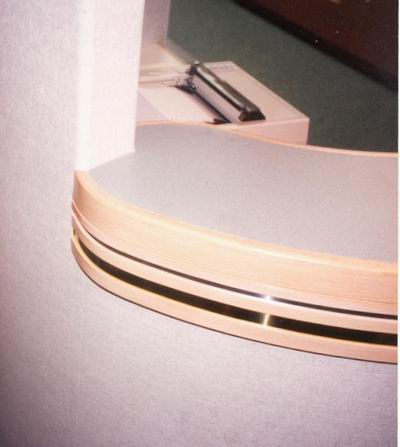Radius Corners on HPL Counters
Applying laminate strip without pull-away problems. May 19, 2004
Question
I'm looking for suggestions on applying the front strip of laminate on the face counter, which has a radiused corner. Radius is roughly 2.75". I usually heat the piece up with an iron, hold it against the radius before gluing, let it cool off, then glue it on. Inevitably, it pulls off somewhat at the ends of the radius, and I end up putting a clamp on it for awhile. There's got to be a better way to do this. I use a template to rout the radius on the substrate.
Forum Responses
(Laminate and Solid Surface Forum)
Try belt sanding the back side of the laminate where the round corner will be. That is the way I do it.
I have also done what is recommended above when belt sanding the back of the laminate on tight radiuses, or on 2" or less radiuses use vertical grade laminate if it is available. I have done 2" radiuses with general purpose laminate by belt sanding the back, working the sander 8-12" on each side of where it hits the radius, and also using a heat gun on low heat to get a tight bend. It also helps to sand or file the edges of the piece you will be bending with a slight radius on each edge so it doesn't start to crack or craze when bending the tight radius. Make sure you get a good double coat of glue on the edges also. I have done many 3" radiuses with the heat gun only, heating the laminate while it is partially applied, then pulling it tight around the radius. You need to keep rolling over it with a J-roller until it cools down some. I also template route the radius on the countertops as you indicated.
All of our tops have a 1 1/2" or 2" radius at the outside corners. We spray both pieces and apply the longest part first. Next we form the laminate around the corner with an electric iron. Start with the iron just slightly past parallel with the stuck edge, and the loose strip making full contact with the bottom of the iron to preheat it. Slowly force the p-lam around the corner, applying tension on the loose end.
It is important to note that different brands of laminate require more or less time to form. Try practicing with an "air" bend to get the time down. Some brands will pop or blister on the surface if heated too long.
I have found that sanding the back of lam to form a tight radius is only needed for <1" radii. Try this - glue both pieces as usual and apply your strip to the longest edge first, then roll. At the bend, file the top and bottom edges of the strip perpendicular to the face for an inch or two on both sides of the radius. This will get rid of the micro-fractures (caused by sawing or slitting the lam).Use a heat gun on the inside of the strip at the radius for a few seconds, then transfer the heat to the outside. While heating, bend the lam around the corner - you can feel when you have enough pliancy. The critical part of this process is the filing, which only takes 5 or 6 seconds per edge. I recently used this method to form 180 1" bends with only two cracked edges - the ones I forgot to file. This filing method is used before bending sheet metal. One more tip - make sure your routing template produces a radius with no bump. If it does, rework the jig to make a smooth radius.
